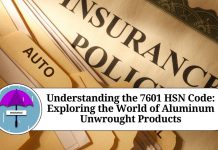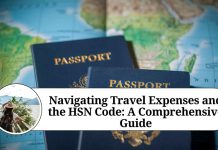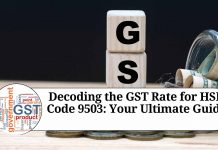In the world of international trade and commerce, a standardized system for classifying goods is crucial. This classification system helps in determining various aspects such as import/export duties, taxation, and tracking of goods. One such system is the Harmonized System of Nomenclature (HSN), which assigns a unique code to each product category. In this blog, we will delve into the realm of bearings and explore the HSN code associated with them.
What are Bearings?
Before we dive into the HSN code, let’s first understand what bearings are. Bearings are mechanical components used to enable rotational or linear movement, reducing friction and enhancing efficiency. They are widely utilized in various industries, including automotive, aerospace, industrial machinery, and more. Bearings play a vital role in supporting and guiding moving parts within a machine, ensuring smooth and reliable operation.
What is the HSN Code?
The HSN code, also known as the Harmonized System of Nomenclature code, is an internationally accepted classification system for goods. It was developed by the World Customs Organization (WCO) to provide a uniform classification for products in global trade. The HSN code consists of a series of numbers assigned to different categories of products, enabling countries to establish customs tariffs, statistical analysis, and other trade-related regulations.
Bearing HSN Code: In the HSN system, bearings fall under the category of machinery and mechanical appliances, as well as parts thereof. The specific HSN code for bearings may vary depending on factors such as the type of bearing, its intended use, and other specifications. However, in general, the HSN code for bearings is 8482.
The code “8482” denotes the category of “Ball or Roller Bearings” within the HSN system. This category encompasses a wide range of bearings, including but not limited to:
- Ball bearings: These bearings use balls to support the rotational or linear movement between two surfaces. They are commonly found in applications such as automotive wheels, conveyor systems, and electric motors.
- Roller bearings: Unlike ball bearings, roller bearings utilize cylindrical or tapered rollers to reduce friction. They are commonly used in heavy machinery, industrial equipment, and vehicle transmissions.
- Thrust bearings: Thrust bearings are designed to handle axial loads, allowing rotational movement in a particular direction. They are often found in applications like automotive transmissions and helicopter rotors.
It is essential to note that the HSN code for bearings may have additional digits or subcategories depending on the specific type, size, or purpose of the bearing. These further classifications within the HSN system enable a more precise categorization of bearings for customs and trade purposes.
Importance of Bearing HSN Code: Understanding the HSN code for bearings is crucial for various stakeholders involved in international trade. Here’s why:
- Customs and import/export regulations: The HSN code helps customs authorities classify and track goods efficiently. It ensures that the correct import/export duties, taxes, and other regulatory requirements are applied to bearing products.
- Pricing and documentation: Manufacturers, suppliers, and traders rely on the HSN code to determine the correct pricing and documentation related to bearings. It simplifies invoicing, shipping, and other administrative processes involved in international trade.
- Statistical analysis: The HSN code enables governments and organizations to gather accurate trade data for statistical analysis. It helps in monitoring industry trends, identifying market demands, and formulating effective policies.
Conclusion
In the vast world of international trade, the HSN code plays a significant role in classifying goods accurately. For bearings, the HSN code 8482 is the general category code. However, it is crucial to consult the specific subcategories or additional digits within the code to provide precise.
Read more useful content:
Frequently Ask Question
Q1: What is the HSN code for bearings?
A1: The HSN code for bearings is 8482. This code represents the category of “Ball or Roller Bearings” within the Harmonized System of Nomenclature (HSN).
Q2: Are there different HSN codes for different types of bearings?
A2: Yes, there can be further classifications or subcategories within the broader HSN code 8482 to specify different types, sizes, or purposes of bearings. These subcategories allow for more precise classification and identification of specific bearing products.
Q3: Why is the HSN code important for bearings?
A3: The HSN code is essential for various reasons:
- Customs and import/export regulations: It helps customs authorities classify and track bearing goods accurately for appropriate application of import/export duties, taxes, and regulatory requirements.
- Pricing and documentation: Manufacturers, suppliers, and traders rely on the HSN code to determine the correct pricing and documentation for bearing products, simplifying invoicing, shipping, and other administrative processes.
- Statistical analysis: The HSN code enables governments and organizations to gather accurate trade data for statistical analysis, industry monitoring, market trend identification, and policy formulation.
Q4: How can I find the specific HSN code for a particular type of bearing?
A4: To find the specific HSN code for a particular type of bearing, you can consult official HSN code directories provided by customs authorities or governmental agencies. These directories outline the detailed classification system, including subcategories, and can assist in identifying the appropriate HSN code for your specific bearing product.
Q5: Can the HSN code for bearings vary from country to country?
A5: While the broader HSN code for bearings (8482) remains the same internationally, some countries may have additional national or regional subcategories or modifications to the HSN code. Therefore, it is advisable to consult the customs regulations and HSN code directories of the specific country you are dealing with to ensure accurate classification.
Q6: Are there any exemptions or specific regulations related to the HSN code for bearings?
A6: Exemptions or specific regulations related to the HSN code for bearings can vary from country to country. Some countries may have specific import/export duties, restrictions, or preferential treatment for certain types of bearings based on their intended use, origin, or other factors. It is important to research and comply with the customs regulations and trade policies of the relevant country.
Q7: Can the HSN code for bearings change over time?
A7: Yes, the HSN code system is periodically updated and revised to accommodate changes in technology, industry practices, and international trade. It is recommended to stay updated with the latest versions of the HSN code directories or consult with customs authorities to ensure compliance with the most current codes.




















